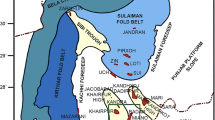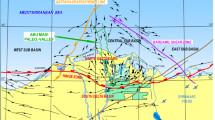Abstract
This work introduces a new method for simulating facies distribution with two categories based on Fourier analysis of Boolean functions. According to this method, two categories of facies distributed along vertical wells are encoded as Boolean functions taking two values. The subsequent simulation process is divided into three consecutive steps. First, Boolean functions of the well data are decomposed into a binary version of a Fourier series. Decomposition coefficients are then simulated over the two-dimensional area as stationary random fields. Finally, synthetic data in the interwell space are reconstructed from simulated coefficients. The described method was implemented experimentally in software and tested on a case of a real oil field and on a case of a synthetic oil field model. Simulations on the synthetic model were used to test the performance of the method for two different bases in the Fourier expansion (Walsh functions and Haar wavelets). The simulation results were compared to those obtained on the same synthetic model via the classical sequential indicator simulation. It was shown that, for both bases, the new method reproduces statistical parameters of the well data better than sequential indicator simulation.













Similar content being viewed by others
Notes
Alternatively, as by the original paper of Baykov et al. (2010), covariance functions \(K_j\) could be estimated non-parametrically via the periodogram-based techniques. Sadly, this approach works well in practice only when one has a large amount of data, which rarely happens in the study of petroleum reservoirs, or requires substantial hand tuning. The parametric covariance function estimation for the spectral approach is discussed in the recent work Ismagilov et al. (2020a).
Actually, Walsh functions do induce a vertical stationarity assumption, but in a very irregular way. This is not the classical stationarity with respect to the translation on the real line, but it is the stationarity with respect to the bitwise xor operation acting on infinite binary representations of numbers in the [0, 1) interval. This cannot be easily spotted with the naked eye, though. The stationarity property is due to the fact that Walsh functions are precisely the characters of the dyadic group \(\{0,1\}^\infty \) under Pontryagin duality (Folland 2016).
In practice, for Walsh functions, the adaptive basis often coincides with the first M functions in Walsh ordering. Intuitively, this shows that this ordering closely reflects the importance of basis functions and that the importance of basis functions does not depend heavily on the particular data.
References
Ahmed N, Rao KR (1975) Orthogonal transforms for digital signal processing. Springer, New York
Armstrong M, Galli A, Beucher H, Loc’h G, Renard D, Doligez B, Eschard R, Geffroy F (2011) Plurigaussian simulations in geosciences. Springer, London
Baykov VA, Bakirov NK, Yakovlev AA (2010) New methods in the theory of geostatistical modeling. Vestnik UGATU 14(2–37):209–215 ((in Russian)
Bonham-Carter GF (2014) Geographic information systems for geoscientists: modeling with GIS. Elsevier, London
Candès EJ, Donoho DL (1999) Ridgelets: a key to higher-dimensional intermittency? Philos Trans R Soc Lond Ser A Math Phys Eng Sci 357(1760):2495–2509
Chilès J-P, Delfiner P (2012) Geostatistics: modeling spatial uncertainty. In: Wiley series in probability and statistics, 2nd edn, vol 713. Wiley, Hoboken
Crama Y, Hammer PL (2011) Boolean functions: theory, algorithms, and applications. Cambridge University Press, Cambridge
Daubechies I (1992) Ten lectures on wavelets. Ser.: CBMS-NSF Regional Conference Series in Applied Mathematics, vol. 61. SIAM, New York
Demicco RV, Klir GJ (2003) Fuzzy logic in geology. Elsevier, London
Dubrule O (2017) Indicator variogram models: Do we have much choice? Math Geosci 49(4):441–465
Eidsvik J, Mukerji T, Switzer P (2004) Estimation of geological attributes from a well log: an application of hidden Markov chains. Math Geol 36(3):379–397
Fine NJ (1949) On the Walsh functions. Trans Am Math Soc 65(3):372–414
Folland GB (2016) A course in abstract harmonic analysis, vol 29. CRC Press, London
Grana D, Fjeldstad T, Omre H (2017) Bayesian Gaussian mixture linear inversion for geophysical inverse problems. Math Geosci 49(4):493–515
Haar A (1910) Zur Theorie der orthogonalen Funktionsysteme. Math Ann 69:331–371
Ismagilov N, Lifshits M (2018) Conditioning spectral simulation method by horizontal well data. In: Proceedings of the conference ECMOR XVI, Barcelona. Report P069. https://doi.org/10.3997/2214-4609.201802198
Ismagilov N, Popova O, Trushin A (2019) Effectiveness study of the spectral approach to geostatistical simulation. In: Proceedings of the conference SPE annual technical conference and exhibition. Society of Petroleum Engineers, Calgary. https://doi.org/10.2118/196106-MS
Ismagilov N, Azangulov I, Borovitskiy V, Lifshits M, Mostowsky P (2020a) Bayesian inference of covariance parameters in spectral approach to geostatistical simulation. Proc Conf ECMOR XVII. https://doi.org/10.3997/2214-4609.202035092
Ismagilov NS, Lifshits MA, Yakovlev AA (2020b) A new type of conditioning of stationary fields and its application to the spectral simulation approach in geostatistics. Math Geosci. https://doi.org/10.1007/s11004-020-09872-3
Kashin BS, Saakyan AA (1989) Orthogonal series. Ser.: Transl. Math. Monographs, vol. 75. AMS, Providence
Lindberg DV, Grana D (2020) Petro-elastic log-facies classification using the expectation–maximization algorithm and hidden Markov models. Math Geosci 47(6):719–752
Mallat S (1999) A wavelet tour of signal processing. Elsevier, London
Norberg T, Rosén L, Baran A, Baran S (2002) On modelling discrete geological structures as Markov random fields. Math Geol 34(1):63–77
O’Donnell R (2014) Analysis of Boolean functions. Cambridge University Press, New York
Pardo-Iguzquiza E, Chica-Olmo M (1993) The Fourier integral method: an efficient spectral method for simulation of random fields. Math Geol 25(2):177–217
Pyrcz MJ, Deutsch CV (2014) Geostatistical reservoir modeling, Oxford
Rasmussen CE, Williams CK (2006) Gaussian processes for machine learning. MIT Press, Cambridge
Terras A (1999) Fourier analysis on finite groups and applications. Cambridge University Press, Cambridge
Vretblad A (2003) Fourier analysis and its applications, vol 223. Springer, London
Walnut DF (2013) An introduction to wavelet analysis. Springer, New York
Walter GG, Shen X (2018) Wavelets and other orthogonal systems. CRC Press, London
Wang H, Xiang S (2012) On the convergence rates of Legendre approximation. Math Comput 81(278):861–877
Acknowledgements
The authors are grateful to both anonymous referees for stimulating advice that helped to clarify the representation of the results.
Author information
Authors and Affiliations
Corresponding author
Additional information
Research was partially supported by Russian Science Foundation Grant 19-71-30002.
Rights and permissions
About this article
Cite this article
Ismagilov, N., Borovitskiy, V., Lifshits, M. et al. Boolean Spectral Analysis in Categorical Reservoir Modeling. Math Geosci 53, 305–324 (2021). https://doi.org/10.1007/s11004-021-09919-z
Received:
Accepted:
Published:
Issue Date:
DOI: https://doi.org/10.1007/s11004-021-09919-z




